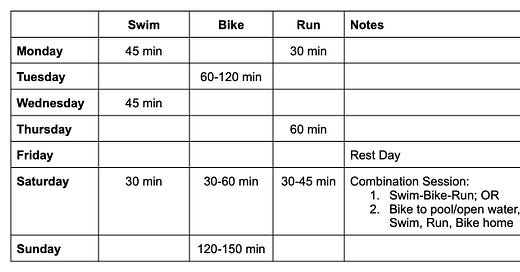The previous chapters have provided specifics regarding endurance, nutrition, physiology, strength training and sport-specific performance. It is time to simplify our thinking and consider the application of everything we’ve shared.
The optimal program is enjoyable, fits the athlete’s life structure and results in gradual improvement.
Every athlete’s program starts with the concept of a Basic Week. The Basic Week is a structure the athlete can hit without fail, week in and week out.
We are going to share a progression from complete Novice through to Top Amateur.
Athletes who want to train at a higher level must create space in their schedules BEFORE adding load.
The progression I (Gordo) followed from Novice to Top Amateur:
Something most mornings.
Something every morning.
Something every morning, and going long on the weekends.
Something every morning, going long on the weekends, and double sessions some weekdays.
Gain Control of All My Mornings.
These stages matched my competitive level:
Improve Health.
Novice Athlete.
Developing Athlete.
Competitive Athlete.
Top Amateur.
A higher level of performance is not better, it’s simply higher. Meaning, we’ve yet to come across any medical professionals with a convincing case that exercising more than “most mornings” leads to better health outcomes. As coaches, we’ve also seen that even a little too much can lead to staleness, loss of enjoyment and maladaptation. Our best results come from spending most of the year under the limit imposed by our current life situation.
The ideal loading pattern for a serious amateur athlete is to train like a low-volume elite.
Stress (training, life or work) is front-loaded in the day. The most important thing is done early.
The rest of the day is lower stress, setting up a good night’s sleep.
Gaining control of as many mornings as possible is the easiest way to achieve this goal.
If controlling the morning schedule is not possible then place a Basic Week into the weekly calendar and repeat that week.
Hold the same slots open every week.
Get everyone around the athlete familiar with the routine.
Set minimums at easily achieved levels.
Avoid the temptation to do anything that screws up tomorrow, or next week.
Race distances beyond current capacity.
Spontaneous Tempo.
Max Efforts.
Travel.
Constantly Changing Protocols.
Repeat The Week
Before spending energy worrying about what to do, create a habit of doing.
How long to repeat the week?
Start with a 15 Week block (105 days).
See how many days (out of 105) the athlete can hit the plan.
If there is more than one missed workout per week then the plan is set too high.
Focus solely on workout completion.
Do not worry about workout progression, yet.
Once 15 weeks have passed, look backwards and assess:
The weekly volume the athlete can absorb.
The workout frequency achieved, by sport.
In short, the athlete will be able to have a conversation with their coach, or themselves, about a realistic schedule, key workouts and their zones.
Keep reading with a 7-day free trial
Subscribe to Endurance Essentials to keep reading this post and get 7 days of free access to the full post archives.





